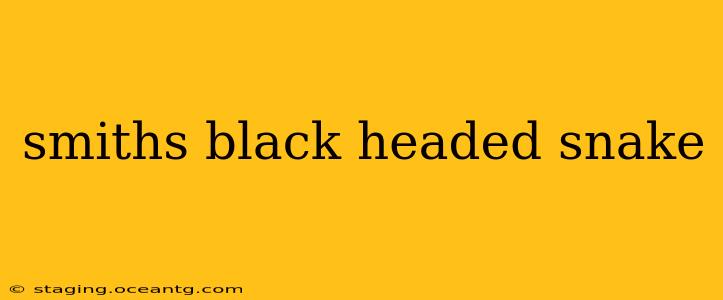The Smiths Black-Headed Snake ( Tantilla melanocephala) is a relatively small, non-venomous snake species found in specific regions of North America. While not as widely known as some other snakes, its unique characteristics and habitat make it a fascinating subject for herpetologists and nature enthusiasts alike. This guide provides a comprehensive overview of this intriguing reptile, addressing common questions and offering detailed insights into its biology and ecology.
What is a Smiths Black-Headed Snake?
The Smiths Black-Headed Snake is a slender, secretive species belonging to the family Colubridae. As its name suggests, it's characterized by its distinctive black head, contrasting sharply with its generally light-brown or gray body. The scales are smooth, and its size is modest, typically reaching a maximum length of around 20 inches. They are often mistaken for other small, slender snakes, highlighting the importance of careful identification based on specific features.
Where are Smiths Black-Headed Snakes Found?
Smiths Black-Headed Snakes have a relatively restricted geographic range. They are primarily found in the southwestern United States, inhabiting specific habitats within Arizona, New Mexico, and parts of Texas. Their preferred environment often includes areas with rocky outcrops, grasslands, and scrublands. They are often found under rocks, logs, or other debris, reflecting their secretive and terrestrial nature.
What do Smiths Black-Headed Snakes Eat?
These snakes are primarily insectivores, meaning their diet consists mainly of insects. Their diet typically includes ants, beetles, and other invertebrates. Their slender body shape and small size are well-suited for foraging in tight spaces and capturing their preferred prey. The specific insect species they consume will vary depending on the availability of food in their local environment.
Are Smiths Black-Headed Snakes Venomous?
No, Smiths Black-Headed Snakes are not venomous. They are completely harmless to humans. While they may bite if handled roughly, their bite poses no threat beyond a minor scratch. This harmless nature makes them a relatively safe species to observe in their natural habitat, although it's always best to admire them from a respectful distance and avoid unnecessary handling.
How can I Identify a Smiths Black-Headed Snake?
Identifying a Smiths Black-Headed Snake requires careful observation. Key features include:
- Black Head: The most distinctive characteristic, a sharply defined black head.
- Slender Body: A relatively thin and elongated body.
- Smooth Scales: Smooth scales without keels (ridges).
- Coloration: Light brown or gray body with a contrasting black head.
- Size: Generally small, reaching a maximum length of around 20 inches.
It's crucial to consult field guides and utilize reliable identification resources to ensure accurate species identification. Mistaking it for other similar species is entirely possible.
What is the Conservation Status of the Smiths Black-Headed Snake?
Currently, the conservation status of the Smiths Black-Headed Snake isn't considered critically threatened. However, like many reptile species, their populations are sensitive to habitat loss and degradation. Protection of their natural habitats remains essential for the long-term survival of this fascinating species.
Conclusion
The Smiths Black-Headed Snake, while understated, presents an excellent case study of the diversity and adaptation found within the reptile world. Its unique characteristics, restricted range, and ecological role all contribute to its significance. Understanding its biology and conservation needs is crucial for ensuring its continued presence in the ecosystems it calls home. Further research into its specific behavioral patterns and population dynamics remains valuable for a deeper appreciation of this intriguing snake.
